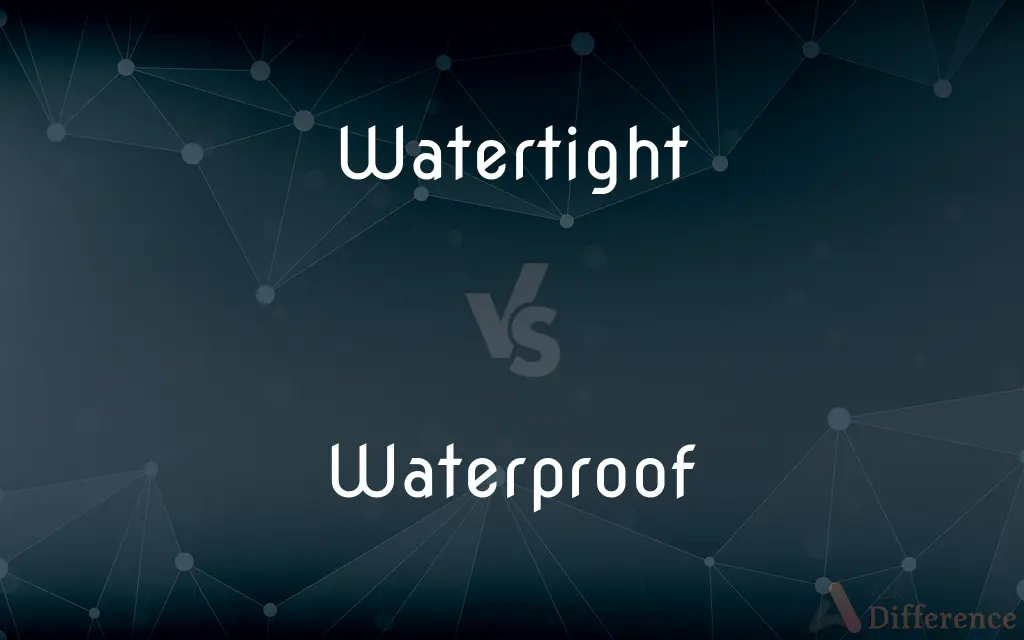Watertight vs. Waterproof — What's the Difference?
Edited by Tayyaba Rehman — By Fiza Rafique — Updated on April 3, 2024
Watertight implies an object can resist water penetration under pressure; waterproof means it's impervious to water under normal conditions.

Difference Between Watertight and Waterproof
Table of Contents
ADVERTISEMENT
Key Differences
Watertight refers to the capability of a container or structure to prevent water from entering, even when submerged or under pressure. This term is often used in contexts where the integrity against water ingress under specific conditions is crucial, such as in the case of ship hulls or watertight compartments. On the other hand, waterproof describes materials or objects that are impervious to water, making them suitable for use in wet conditions. Waterproof items are designed to resist water penetration, regardless of being submerged or exposed to water, but the emphasis is less on resisting pressure and more on general exposure.
The term watertight is applied in scenarios where the pressure of water against a barrier is a significant concern, and it implies a higher level of protection compared to waterproof in such contexts. For instance, a watertight watch can be designed to withstand significant depths, where water pressure is a factor, while a waterproof watch might only be suitable for surface swimming. Waterproof, however, is a broader term that encompasses protection against water ingress but might not specify the conditions, such as depth or pressure, under which the item remains protected.
Watertight seals are crucial in applications where failure to keep water out under pressure could lead to catastrophic outcomes, such as in submarines or flood barriers. Waterproof materials are essential for a wide range of products, including clothing, electronic devices, and outdoor gear, where exposure to rain or splashes is the main concern, rather than submersion under pressure.
In testing and standards, watertight items undergo rigorous procedures to ensure they meet specific criteria for resisting water penetration under pressure. Waterproof items are also tested, but the criteria might focus more on the duration and conditions of exposure rather than the depth and pressure of water.
Understanding the distinction between watertight and waterproof is important when selecting products for specific needs. For example, choosing a watertight container for underwater photography equipment ensures the gear remains dry under pressure, while waterproof boots are sufficient for walking in the rain.
ADVERTISEMENT
Comparison Chart
Definition
Capable of preventing water entry under pressure
Impervious to water under normal conditions
Usage Context
Submersion, significant water pressure
General exposure to water, rain, splashes
Protection Level
Higher, against pressure and submersion
Broad, against general water exposure
Testing Criteria
Resistance to penetration under specific depths and pressure
Resistance to water ingress under specified conditions
Common Applications
Ship hulls, underwater equipment
Clothing, electronics, outdoor gear
Compare with Definitions
Watertight
Used in critical applications where failure is not an option.
Emergency shelters have watertight seals to protect occupants from floods.
Waterproof
Emphasizes protection from water in daily use scenarios.
Waterproof boots keep feet dry in wet or muddy conditions.
Watertight
Requires rigorous testing for certification.
Watertight watches undergo testing to verify their resistance at various depths.
Waterproof
Tested for resistance to water exposure, not necessarily under pressure.
Waterproof tents are tested to ensure they remain dry inside during heavy rain.
Watertight
Often associated with submersion and high pressure.
Watertight containers are essential for deep-sea exploration.
Waterproof
Covers a wide range of products and materials.
Waterproof mascara remains intact during swimming or crying.
Watertight
Designed to prevent the ingress of water under pressure.
The submarine's door must be watertight to ensure the safety of its crew.
Waterproof
Suitable for use in wet conditions without being submerged.
Waterproof smartphones can withstand rain and accidental spills.
Watertight
Implies a complete seal against water entry.
The watertight compartments of the ship prevent sinking in case of hull breach.
Waterproof
Material or construction that resists water penetration.
Waterproof jackets are essential for hiking in rainy weather.
Watertight
So tightly made that water cannot enter or escape.
Waterproof
Impervious to or unaffected by water.
Watertight
Having no flaws or loopholes; impossible to fault, refute, or evade
A watertight alibi.
A watertight contract.
Waterproof
Made of or coated or treated with rubber, plastic, or a sealing agent to prevent penetration by water.
Watertight
So tightly made that water cannot enter or escape.
Waterproof
A material or fabric that is impervious to water.
Watertight
(figurative) So devised or planned as to be impossible to defeat, evade or nullify.
A watertight contract; a watertight regulation
Waterproof
Chiefly British A raincoat or other such outer garment.
Watertight
Having no leaks
Waterproof
To make impervious to water.
Watertight
Not allowing water to pass in or out
Waterproof
Resistant to the effects of water.
Watertight
Without flaws or loopholes;
An ironclad contract
A watertight alibi
A bulletproof argument
Waterproof
Made of or covered with material that doesn't allow water in.
Waterproof
(figurative) Incapable of failing; unassailable.
Waterproof
To make waterproof or water-resistant.
Waterproof
A substance or preparation for rendering cloth, leather, etc., impervious to water.
Waterproof
Cloth made waterproof, or any article made of such cloth, or of other waterproof material, as rubber; especially, an outer garment made of such material.
Waterproof
Proof against penetration or permeation by water; impervious to water; as, a waterproof garment; a waterproof roof.
Waterproof
A substance or preparation for rendering cloth, leather, etc., impervious to water.
Waterproof
Cloth made waterproof, or any article made of such cloth, or of other waterproof material, as rubber; esp., an outer garment made of such material.
Waterproof
To render impervious to water, as cloth, leather, etc.
Waterproof
Any fabric impervious to water
Waterproof
A water-resistant coat
Waterproof
Make watertight;
Waterproof the coat
Waterproof
Not permitting the passage of water
Common Curiosities
Can a waterproof item be used underwater?
Some waterproof items can be used underwater, but the extent depends on their design and testing; for deep or prolonged submersion, watertight is recommended.
What makes an item watertight?
An item is made watertight by its ability to prevent water ingress, even under pressure or when submerged.
How is waterproof different from watertight?
Waterproof means an item can resist water penetration in normal conditions, without the specific pressure resistance implied by watertight.
What is the significance of IP ratings in waterproof products?
IP ratings (Ingress Protection) indicate the level of protection against water and dust, helping consumers understand the extent of water resistance.
Is watertight better than waterproof?
"Better" depends on the intended use; watertight offers more protection under pressure, while waterproof is adequate for general exposure.
How are watertight products tested?
Watertight products are tested by submerging them or subjecting them to water under pressure to ensure no water ingress.
Can waterproof items fail?
Yes, waterproof items can fail if damaged, improperly sealed, or exposed to conditions beyond their tested resistance.
What should I look for in a watertight seal?
Look for seals that are certified to resist water at the depth and pressure relevant to your needs.
Why is understanding the difference important?
Understanding the difference helps in choosing the right product for activities involving water to ensure adequate protection.
Are all waterproof items also watertight?
Not necessarily; while all watertight items are inherently waterproof, not all waterproof items are designed to be watertight.
Can waterproof coatings wear off?
Yes, waterproof coatings can degrade over time, especially with heavy use or exposure to harsh conditions.
What are common uses for watertight products?
Common uses include marine and underwater equipment, emergency gear, and any application where water pressure is a concern.
How should I care for waterproof materials?
Follow manufacturer guidelines for cleaning and maintenance to ensure the waterproof integrity is maintained.
Can watertightness be restored if compromised?
Depending on the product, watertightness can sometimes be restored with the right repairs or by replacing seals.
How do manufacturers ensure products are watertight?
Manufacturers use specific materials and construction methods, followed by rigorous testing to ensure products meet watertight standards.
Share Your Discovery

Previous Comparison
Creditor vs. Lender
Next Comparison
Deer vs. VealAuthor Spotlight
Written by
Fiza RafiqueFiza Rafique is a skilled content writer at AskDifference.com, where she meticulously refines and enhances written pieces. Drawing from her vast editorial expertise, Fiza ensures clarity, accuracy, and precision in every article. Passionate about language, she continually seeks to elevate the quality of content for readers worldwide.
Edited by
Tayyaba RehmanTayyaba Rehman is a distinguished writer, currently serving as a primary contributor to askdifference.com. As a researcher in semantics and etymology, Tayyaba's passion for the complexity of languages and their distinctions has found a perfect home on the platform. Tayyaba delves into the intricacies of language, distinguishing between commonly confused words and phrases, thereby providing clarity for readers worldwide.














































